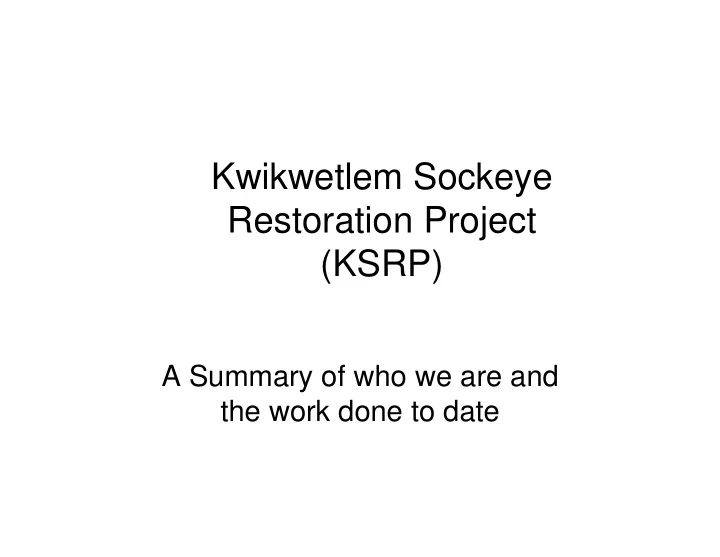

Kwikwetlem Sockeye Restoration Project (KSRP) A Summary of who we are and the work done to date
KSRP – Outline 1. Introduction 2. Location 3. Low Level Outlet (LLO) Gatehouse • smolt output 4. Sockeye Adult Trap • adult returns 5. Challenge 6. Studies • work done to date • Water quality panel
KSRP – Introduction Who: � A group stakeholders who have an interest in the Coquitlam watershed that are working with Kwikwetlem FN to restore an extirpated run of sockeye salmon. Problem: � Construction of Coquitlam dam blocked migratory route of historical sockeye run in 1914. � Landlocked juveniles forced into a freshwater-only life history (i.e., as kokanee) � 25 generations of reservoir existence may have altered the stock’s morphology and behavior
KSRP – Introduction Objective � Restore the extirpated run of sockeye salmon 1. Short term: 1. Establish a sustainable run of sockeye salmon 2. Learn about Kwikwetlem sockeye ecology 2. Long term: 1. Restore the sockeye run given prevailing conditions (i.e., revert landlocked sockeye back to primarily a sea run population)
KSRP – Location
KSRP – Location (3d view) Red line marks elevation of historical lake Coquitlam Dam and forebay
KSRP – Location (Air photo view) Coquitlam Dam and Forebay
KSRP – Location (Dam and Forebay) LLO Gatehouse
KSRP – LLO Gatehouse
KSRP – LLO Gatehouse Typical range of reservoir elevations during smolt out migration Movement of smolts
KSRP – LLO Gatehouse
KSRP – LLO Gatehouse
KSRP – smolt output 1600 First year of 1400 monitoring Estimated Smolt Output 1200 1000 800 600 400 200 < 50 0 2005 2006 2007 2008 2009 2010
KSRP – smolt output Possible reasons for dwindling counts: 1. Structure itself (small opening at depth) 2. Flow too low to attract smolts 3. Reservoir levels too high – LLO too deep 4. Reservoir levels too low – forebay too shallow 5. Diversion tunnel - intercepts smolts 6. Predation 7. Too few smolts in reservoir – no incentive to leave 8. Drive to emigrate lost - natural selection favors ‘stayers’ 9. ???
Adult trap box KSRP – Sockeye Adult Trap
KSRP – Sockeye Adult Trap
KSRP – Sockeye Adult Trap
KSRP – Sockeye Adult Trap
KSRP – Sockeye Adult Returns 12 1 st year of Adult 10 trap operation Adult Returns 8 6 4 No adults 2 expected for 1 st ? 2 years 0 2005 2006 2007 2008 2009 2010
KSRP – Sockeye Adult Returns • Possible reasons for low adult counts • Low smolt output (Smolt to adult survival is usually about 1 in 100) • Trap functional only since 2008 • Error in smolt estimates (unlikely) • From similar work in Alouette Lake Reservoir • Adults survive transport • Appear to successfully spawn
KSRP – Challenge Short term KSRP objective: 1. Establish a sustainable population • Target numbers not yet established • Using Sakinaw Lake sockeye as example: – DFO target minimum: 250 adults – Assuming 1% survival: 25,000 smolts 2. Learn Kwikwetlem sockeye ecology • Study work underway since 2004
KSRP – Study work
Recommend
More recommend